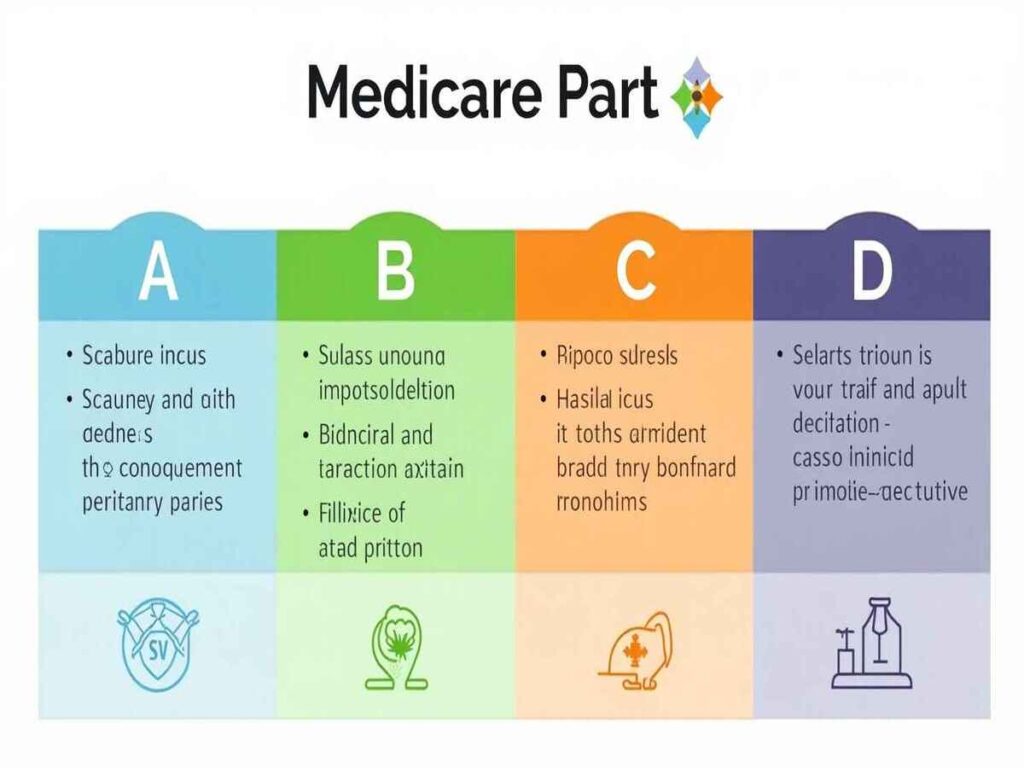Understanding Medicare: A Quick Overview
Let’s kick things off with the basics. Medicare is a federal health insurance program that’s been around since 1965, designed primarily for people aged 65 and older. But here’s the thing—it’s not just for seniors. It also covers certain younger individuals with disabilities or those with specific health conditions like End-Stage Renal Disease (ESRD) and Amyotrophic Lateral Sclerosis (ALS).
Medicare isn’t a one-size-fits-all plan. It’s split into different “Parts”:
- Part A covers hospital stays, nursing care, and some home healthcare.
- Part B takes care of doctor visits, outpatient care, and preventive services.
- Part C (Medicare Advantage) is an alternative to Original Medicare, offered by private companies.
- Part D helps with prescription drug costs.

You can think of it like a build-your-own insurance plan. Some folks stick with Original Medicare (Parts A and B), others go for Medicare Advantage (Part C), and many add a Part D plan or Medigap coverage for the extras Medicare doesn’t cover.
Want trusted resources tailored for those 50 and older? Check out AARP for expert insights on retirement, healthcare, budgeting, and more. 👉 Click here to learn more.
With healthcare costs rising every year, Medicare is more than just a benefit—it’s a safety net that millions rely on. But here’s the kicker: knowing how and when to enroll, and if you’re even eligible, is what separates the prepared from the panicked.
Medicare Eligibility Age
Now, onto the big question: When can you actually get Medicare?
The magic number is 65. That’s the standard age when most people become eligible. Specifically, if you’re turning 65 and you’ve worked long enough to qualify for Social Security or Railroad Retirement benefits, you’re good to go. You’ll be eligible for premium-free Part A and can enroll in Part B by paying a monthly premium.

But there’s more nuance to it.
For most, Medicare eligibility starts the first day of the month you turn 65. For example, if your birthday is July 15, your Medicare starts July 1. But—and here’s a little wrinkle—if your birthday falls on the 1st of the month, your Medicare actually begins a month earlier.
Planning ahead is crucial. Your Initial Enrollment Period (IEP) starts three months before your 65th birthday and ends three months after. That gives you a 7-month window to enroll without penalties.
Missing this window can be costly. For every 12-month period you delay enrolling in Part B without credible coverage, your premium can go up 10% for life.
But what if you’re not ready to retire at 65? Many people are still working, and if you’ve got health insurance through your employer (especially if the company has 20+ employees), you may be able to delay Medicare without penalty. Still, it’s worth comparing your current coverage with what Medicare offers—it could save you thousands.
Exceptions to the Rule: Early Eligibility
While age 65 is the golden rule, there are a few important exceptions that allow you to qualify before that.
1. Disability-Based Eligibility
If you’ve been receiving Social Security Disability Insurance (SSDI) for at least 24 months, you automatically become eligible for Medicare. This applies regardless of your age. On your 25th month of SSDI benefits, Medicare kicks in, and you’ll be enrolled in both Part A and Part B unless you opt out of Part B.
2. ESRD (End-Stage Renal Disease)
People with ESRD, a permanent kidney failure condition requiring dialysis or a transplant, can qualify for Medicare at any age. Eligibility starts the first day of the fourth month of dialysis treatments, or earlier if you’re part of a home dialysis training program or getting a transplant soon.
3. ALS (Amyotrophic Lateral Sclerosis)
Here’s the rarest exception—but arguably the most urgent. If you’re diagnosed with ALS, you’re eligible for Medicare as soon as your Social Security disability benefits begin—there’s no 24-month waiting period. This fast-tracks access to critical care and services for a rapidly progressing disease.
These exceptions are lifelines for millions of Americans. If you or a loved one falls into one of these categories, early Medicare access can be the difference between financial devastation and manageable treatment.
Basic Eligibility Requirements
Being the right age or having a qualifying condition is just part of the picture. You also need to meet a few basic eligibility rules.
Citizenship and Residency Requirements
To qualify for Medicare, you need to be a U.S. citizen or a lawfully present permanent resident who has lived in the country for at least five continuous years. That’s non-negotiable.
If you’re not a citizen but meet the residency criteria and are married to someone who has worked long enough to qualify, you may still be eligible through their work history.
Work History and Tax Contributions
Part A—hospital insurance—is usually premium-free if you or your spouse paid Medicare taxes for at least 40 quarters (that’s 10 years of work). If you didn’t meet this requirement, you can still get Medicare, but you’ll need to pay a monthly premium for Part A.
For Part B and Part D, everyone pays premiums regardless of work history, though higher earners may pay more due to IRMAA (Income-Related Monthly Adjustment Amount).
Even if you never worked a day in your life, as long as you’re 65 and a legal resident, you can buy into Medicare. It just might cost more without that work history.
So what’s the takeaway? Your work history affects what you pay, but not whether you qualify. That’s an important distinction.
Join AARP today and unlock exclusive tools, discounts, and support designed just for your life stage. 👉 Click here to learn more.
Enrolling in Medicare
Alright, let’s talk about how to actually get on board with Medicare. There are several enrollment periods, and missing the right one could cost you—not just in penalties but in delays in coverage.
Initial Enrollment Period (IEP)
This is your first chance to sign up. It’s a 7-month window that starts 3 months before the month you turn 65, includes your birthday month, and continues for 3 months after. Enrolling early ensures your coverage starts on time and helps avoid penalties.
General Enrollment Period (GEP)
If you missed your IEP, don’t panic—but you’ll have to wait. The GEP runs from January 1 to March 31 each year, and your coverage won’t start until July 1. And yes, you might face late penalties.
Special Enrollment Period (SEP)
Working past 65 with employer health coverage? You may qualify for an SEP. Once your employment or insurance ends, you have 8 months to sign up for Part B without penalty. This period is a lifesaver for those delaying retirement.
Automatic vs. Manual Enrollment
If you’re already receiving Social Security benefits when you turn 65, congratulations—you’ll be automatically enrolled in Medicare Part A and B. Otherwise, you’ll need to enroll manually through the Social Security Administration, either online, by phone, or in person.
One last tip? Always confirm your enrollment and start dates. Mistakes can happen, and it’s better to fix them early than be stuck with a bill you didn’t expect.
Different Parts of Medicare Explained
If you’ve heard about Medicare but felt overwhelmed by all the letters—Part A, B, C, and D—you’re not alone. Each part serves a unique purpose, and understanding how they work together is key to getting the right coverage.
Medicare Part A – Hospital Insurance
Part A covers your hospital-related expenses. Think inpatient hospital stays, skilled nursing facility care, hospice care, and limited home health services. For most people who worked and paid Medicare taxes for at least 10 years, this part is premium-free. But don’t mistake “free” for “no cost”—there’s a deductible involved. In 2025, the Part A deductible is $1,632 per benefit period. After that, coinsurance fees may apply depending on how long you’re hospitalized.
For example, after 60 days in a hospital, you start paying a daily coinsurance fee. And if you’re in a skilled nursing facility, you only get full coverage for the first 20 days. So while Part A is a huge help, it won’t cover everything.
Medicare Part B – Medical Insurance
Part B handles outpatient care, preventive services, doctor visits, and medical supplies. This one isn’t free—everyone pays a monthly premium. In 2025, the standard premium is $174.70, but higher-income earners pay more due to IRMAA.
There’s also an annual deductible ($240 in 2025), and after meeting it, you’ll usually pay 20% of the Medicare-approved amount for most services. That 20% can add up fast if you’re managing chronic conditions or seeing specialists.
Still, Part B is essential. Skipping it without credible coverage could land you in penalty territory—10% added to your premium for every 12 months you delay enrollment.
Medicare Part C – Medicare Advantage
Now here’s where it gets interesting. Medicare Advantage (Part C) plans are offered by private insurance companies approved by Medicare. They include everything covered by Part A and B, and often bundle in Part D (prescription drugs) plus extras like dental, vision, hearing aids, and gym memberships.
Sounds great, right? It can be—if you’re okay with network restrictions. Most Advantage plans work like HMOs or PPOs, meaning you may need to use doctors in their network and get referrals for specialists. Also, while these plans have out-of-pocket maximums (a major plus), your actual costs can vary depending on the plan and how much care you need.
Medicare Part D – Prescription Drug Coverage
Original Medicare doesn’t cover most outpatient prescription drugs. That’s where Part D steps in. Offered by private insurers, Part D plans help pay for the medications your doctor prescribes.
Every plan has its own list of covered drugs (called a formulary), and costs will vary. You’ll usually pay a monthly premium, an annual deductible, and coinsurance or copays. And yes, there’s a late enrollment penalty here too—if you go 63 days or more without drug coverage after your IEP, expect a lifelong surcharge on your premium.
Together, these four parts form the foundation of Medicare. Knowing what each one does empowers you to build a plan that fits your life, health needs, and budget.
Costs Associated with Medicare
Let’s break a myth right now—Medicare isn’t free. Sure, some parts may come without a premium, but you’ll still have to budget for a range of costs, including premiums, deductibles, coinsurance, and even late enrollment penalties if you’re not careful.
Premiums for Part A and Part B
As mentioned earlier, Part A is premium-free if you or your spouse worked and paid Medicare taxes for 40 quarters (10 years). If not, you’ll pay up to $505 per month in 2025.
Part B is where the real costs begin. Everyone pays a premium—starting at $174.70 per month in 2025, but possibly more based on income. High-income earners can pay up to $594 monthly due to IRMAA.
Deductibles and Copayments
Let’s say you’re hospitalized. The Part A deductible is $1,632 per benefit period. After 60 days, you start paying a daily coinsurance fee—$408 per day for days 61–90, and $816 per day beyond that unless you use your lifetime reserve days.
Under Part B, you pay the $240 annual deductible, then 20% of approved services. That includes doctor visits, durable medical equipment, lab tests, and outpatient procedures.
Out-of-Pocket Maximums in Medicare Advantage
Original Medicare (Parts A and B) has no out-of-pocket maximum. That’s risky, especially for those with chronic conditions or unexpected medical emergencies.
Advantage plans must set a yearly limit—typically around $7,550 for in-network services. Once you hit that ceiling, the plan covers 100% of additional in-network costs. That cap is a major reason people opt for Advantage plans, even if they come with stricter provider rules.
Other Costs to Consider
- Prescription drugs under Part D also have premiums, deductibles, and copays. And don’t forget the infamous “donut hole,” a coverage gap where you might pay more out of pocket.
- Medigap plans (for those with Original Medicare) come with monthly premiums too, but they help cover out-of-pocket expenses like Part B coinsurance and hospital fees.
👉 Timing is everything when it comes to Medicare. Missing an enrollment deadline could mean facing penalties for life. Check out Medicare Enrollment Deadlines and Penalties: What Every Beneficiary Must Know to Avoid Lifetime Costs to make sure you’re fully aware of the critical dates and how to steer clear of costly mistakes.
Bottom line? Medicare is affordable for most, but not free. A smart beneficiary compares plans, keeps track of enrollment periods, and looks for coverage that balances premiums with out-of-pocket protection.
Medicare for People with Disabilities
While most people think Medicare is only for seniors, millions of Americans under age 65 qualify due to disability. In fact, over 8 million people under 65 are Medicare beneficiaries because of a qualifying medical condition or disability.
SSDI and Medicare Eligibility
If you’re under 65 and have a long-term disability, you can qualify for Medicare after receiving Social Security Disability Insurance (SSDI) for 24 months. On the 25th month of receiving SSDI, your Medicare coverage begins automatically. This includes both Part A and Part B unless you choose to decline Part B (though most people don’t).
This automatic enrollment helps disabled individuals who may already be overwhelmed with medical appointments, treatments, and financial burdens. You don’t need to apply separately unless you want to add a Medicare Advantage or Part D plan.
Waiting Period for Disabled Individuals
The 24-month waiting period can feel like a lifetime if you’re dealing with serious health issues. Some may qualify for Medicaid or state programs during this period to help cover healthcare costs. If you’re in this situation, make sure to contact your state Medicaid office to check eligibility.
Keep in mind, Medicare doesn’t necessarily end if you return to work. There are work incentive programs that allow you to keep Medicare coverage while working under certain conditions. This flexibility supports those who want to try reentering the workforce without losing their safety net.
How ALS and ESRD Change the Rules
There are two major exceptions to the 24-month wait rule:
- ALS (Amyotrophic Lateral Sclerosis): If you’re diagnosed with ALS, your Medicare begins the same month you start receiving SSDI benefits. This fast-tracked access to healthcare is critical for managing a disease that progresses rapidly.
- ESRD (End-Stage Renal Disease): If you have permanent kidney failure requiring regular dialysis or a transplant, you’re eligible for Medicare regardless of age. Your coverage typically begins on the first day of the fourth month of dialysis, or earlier in some home dialysis cases or if you’re scheduled for a transplant.
These exceptions ensure that people facing the most severe and immediate health threats aren’t left waiting months or even years for the coverage they need.
How to Apply for Medicare
Let’s say you’re approaching 65 or recently qualified through disability. How do you actually sign up for Medicare? The good news: it’s easier than you think—especially if you plan ahead and gather the right documents.
Applying Online, by Phone, or in Person
Most people enroll in Medicare through the Social Security Administration (SSA). You have three options:
- Online: Go to ssa.gov/medicare. It’s fast, easy, and available 24/7.
- By phone: Call Social Security at 1-800-772-1213 to speak with a representative.
- In person: Visit your local Social Security office (appointments may be required).
If you’re already receiving Social Security benefits when you turn 65, you’ll be automatically enrolled in Part A and Part B. A welcome packet with your Medicare card arrives about three months before your birthday.
What Documents Do You Need?
Be prepared to provide:
- Proof of age (like a birth certificate)
- Social Security number
- Proof of U.S. citizenship or lawful residency
- Work history information (especially if you’re applying for premium-free Part A)
- Tax documents (for income-related premium calculations)
Having these documents ready will speed up the process and prevent delays.
Mistakes to Avoid During Enrollment
Enrollment seems simple, but common mistakes can lead to long-term consequences. Watch out for:
- Missing your Initial Enrollment Period without having credible coverage. This can trigger lifetime penalties.
- Delaying Part B because you assume you won’t need it—only to find out your employer coverage doesn’t qualify as credible.
- Forgetting to enroll in Part D or assuming you’ll never need prescriptions. Late enrollment penalties apply here too.
- Not reviewing your options annually. Medicare plans can change yearly—so should your choices.
The bottom line? Be proactive, ask questions, and don’t assume Medicare will just “happen.” It takes planning, especially if you have special needs or unique circumstances.
Penalties for Late Enrollment
Delaying Medicare enrollment can cost you—and not just once. Some penalties stick with you for the rest of your life. That’s why understanding when and how to enroll is critical.
Part A Late Enrollment Penalties
If you don’t qualify for premium-free Part A and you don’t sign up when first eligible, your premium could increase by 10%. You’ll pay that higher amount for twice the number of years you delayed enrollment.
For example, if you waited two years, you’ll pay the increased rate for four years.
Part B Late Enrollment Penalties
This is the most common mistake. If you delay signing up for Part B and you don’t have credible coverage (like from a large employer), you’ll pay an extra 10% for every 12-month period you could’ve had Part B.
Here’s the kicker: this penalty never goes away. You’ll pay the higher premium for life. Ouch.
Part D Late Enrollment Penalties
Prescription drug coverage penalties are sneaky. If you go 63 consecutive days or more without Part D or other credible drug coverage, you’ll face a penalty when you finally enroll.
That penalty equals 1% of the national base premium multiplied by the number of full months you went without coverage. This amount is then added to your monthly Part D premium—and yes, it’s also a lifetime penalty.
Avoiding Penalties
Here’s how to stay penalty-free:
- Know your enrollment windows and mark your calendar.
- Understand what qualifies as credible coverage (especially from employers).
- If in doubt, enroll. The cost of coverage is often far less than the penalties for not enrolling.
Medicare and Employer Coverage: How They Work Together
It’s becoming more common for people to work past age 65. So, what happens when you’re eligible for Medicare but still getting insurance through your job? The answer depends on your employer’s size and whether the coverage you have is considered “credible.”
If your employer has 20 or more employees, your group health plan is considered primary, and Medicare acts as secondary. That means your employer’s insurance pays first, and Medicare pays any remaining eligible costs. In this situation, you may be able to delay enrolling in Part B without penalty—as long as your employer plan is considered credible.
If your employer has fewer than 20 employees, Medicare becomes your primary insurance, and your employer plan pays secondary. In this case, you should sign up for Medicare when you’re first eligible, even if you plan to keep working. Delaying could result in denied claims or high out-of-pocket costs.
Don’t forget to compare costs. Some people find that Medicare, combined with a Medigap and Part D plan, costs less than what their employer offers. Others prefer the simplicity of sticking with one employer plan. The key is to evaluate and run the numbers. And remember, if you decide to retire later, you’ll qualify for a Special Enrollment Period (SEP) to sign up for Medicare without penalty.
Also important: If you’re contributing to a Health Savings Account (HSA) and you enroll in any part of Medicare, you can no longer make HSA contributions. Plan ahead and stop HSA contributions six months before you enroll to avoid tax penalties.
Working and Medicare can go hand in hand—but only if you know the rules.
Medicare Supplement Insurance (Medigap)
Even with Medicare, you’ll still have out-of-pocket costs. That’s where Medigap plans come in. These are private insurance policies designed to cover the “gaps” in Original Medicare, like deductibles, copays, and coinsurance.
There are currently 10 standardized Medigap plans (A through N), each offering different levels of coverage. Some are high-deductible plans with low premiums; others, like Plan G or Plan N, offer near-comprehensive coverage at a higher premium. Medigap can be a great option if you want predictable costs and the freedom to see any doctor who accepts Medicare.
To buy a Medigap plan, you must be enrolled in Medicare Part A and Part B. And the best time to enroll is during your Medigap Open Enrollment Period, which starts the first month you’re 65 and enrolled in Part B. During this six-month window, insurers can’t deny you coverage or charge more based on your health.
But outside that period? Things get trickier. You might be subject to medical underwriting, meaning insurers can charge more—or deny you—based on pre-existing conditions. That’s why timing is everything when it comes to Medigap.
Also, Medigap plans don’t cover prescription drugs, so you’ll still need a separate Part D plan. They also don’t include extras like dental or vision, which some Medicare Advantage plans offer.
Medigap is perfect for people who travel often or want nationwide access to providers without worrying about network restrictions. It’s all about balancing cost, flexibility, and simplicity.
Medicare Advantage vs. Original Medicare: Pros and Cons
Choosing between Original Medicare and Medicare Advantage is like picking between two different styles of coverage. Each has its benefits—and drawbacks.
Original Medicare offers broad access to doctors and hospitals across the country. You can go to any provider that accepts Medicare—no referrals needed. This flexibility is especially attractive for snowbirds, frequent travelers, or those who want full control over their providers.
However, Original Medicare doesn’t cap your out-of-pocket costs. That’s why many people pair it with a Medigap plan to protect against high expenses and add predictability. You’ll also need to purchase a Part D plan to cover prescriptions.
Medicare Advantage (Part C), on the other hand, is an “all-in-one” alternative offered by private insurers. These plans usually include Part A, B, and D, and many offer extra perks like dental, vision, and wellness programs. They often come with lower premiums—some even have a $0 monthly cost—but require you to use a network of providers.
Some Advantage plans require referrals to see specialists. Others charge higher fees for out-of-network care or may not cover it at all. On the flip side, all Medicare Advantage plans have an annual out-of-pocket max, which Original Medicare lacks. In 2025, that limit is typically around $7,550, though some plans offer lower caps.
So which is better?
- Go with Original Medicare + Medigap + Part D if you want nationwide access, don’t mind paying a bit more, and value choice.
- Choose Medicare Advantage if you prefer all-in-one coverage, lower premiums, and extra benefits—but are okay with using a provider network.
Ultimately, the right choice depends on your healthcare needs, financial situation, and lifestyle.
Common Myths About Medicare
Let’s clear up some of the most common misunderstandings that trip people up.
“Medicare is free.”
Not quite. Part A may be premium-free if you’ve worked long enough, but Part B and D come with monthly premiums. And you’ll still pay deductibles, copays, and coinsurance.
“I’m automatically enrolled when I turn 65.”
Only true if you’re already receiving Social Security or Railroad Retirement benefits. If not, you must actively enroll yourself.
“Medicare covers everything.”
Nope. Medicare doesn’t cover long-term care, most dental or vision services, hearing aids, or routine foot care. That’s why many people add Medigap or Advantage plans for more complete coverage.
“I don’t need Part B if I’m healthy.”
Skipping Part B without other credible coverage can result in a lifetime penalty. Don’t risk it.
“Medicare Advantage and Medigap are the same.”
They’re completely different. You can’t have both. Advantage replaces Original Medicare, while Medigap works with it.
Being misinformed can cost you—literally. Make sure you get your info from reliable sources, not just your neighbor’s advice.
How to Avoid Medicare Scams and Fraud
Unfortunately, where there’s a system with a lot of money, there’s fraud. Medicare scams are everywhere, and they target the most vulnerable. But you can protect yourself by knowing the red flags.
Never share your Medicare number unless you’re talking to a trusted provider or agent. Treat it like your Social Security number.
Beware of unsolicited calls offering free medical equipment, tests, or plans. These are usually scams trying to bill Medicare for unnecessary services or steal your identity.
Don’t fall for high-pressure tactics. Scammers may claim you’re about to lose your coverage or that a “new card” is required. Medicare will never call you out of the blue like this.
Check your Medicare Summary Notice (MSN) or Explanation of Benefits (EOB) for unfamiliar charges. Report anything suspicious to Medicare at 1-800-MEDICARE or your local Senior Medicare Patrol.
A little awareness goes a long way. Staying informed is your best defense.
Conclusion
Navigating Medicare can feel like learning a second language, but once you understand the basics—eligibility age, enrollment periods, plan types, and costs—it becomes much easier to manage. Whether you’re nearing 65, living with a disability, or helping a loved one through the process, being prepared and informed will save you money, time, and stress.
Remember, Medicare isn’t one-size-fits-all. It’s a mix-and-match system that should reflect your health needs, financial situation, and lifestyle. Take the time to compare options, understand deadlines, and ask questions. It’s your health, your money, and your future on the line.
Want trusted resources tailored for those 50 and older? Check out AARP for expert insights on retirement, healthcare, budgeting, and more. Join today and unlock exclusive tools, discounts, and support designed just for your life stage. 👉 Click here to learn more.




